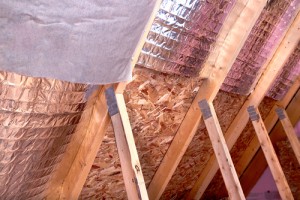What do you know about radiant barrier decking or sheathing? It’s a great investment for your home that can lower energy costs and keep your home significantly cooler throughout the summer. Those advantages are among the reasons that Perry Hood Properties installs radiant barrier decking in all of our homes. While there are many benefits to be had from installing radiant barrier decking in your attic, there is also a lot of misinformation available. To better understand exactly what you’re getting, here are a few common myths and an explanation of the truth behind them.
- Energy Savings
Radiant barrier decking is installed between rafters and shingles in order to reflect heat and keep air temperatures in the attic and the home cooler. That results in reduced cooling costs throughout the summer, especially in warmer climates like Oklahoma. There are many factors involved in the energy savings, however, so any specific savings claims should not be trusted. Typically, savings will depend at least partly on the direction your home faces, the climate outside and the occupant’s lifestyle and habits.
- Shingle Deterioration
Many have speculated that installing radiant barrier decking will accelerate the rate at which your shingles deteriorate. This is backed by the fact that shingles experience hotter temperatures throughout the summer. Temperatures could increase as much as 10-degrees on shingles. However, this is not expected to greatly impact the longevity of the shingles. In fact, the color of asphalt shingles will play a bigger factor in how long they stand up to the summer sun than will the presence of radiant barrier decking.
- Dust and Proper Installation
There are two common problems with radiant barrier decking that result in diminished performance. First, there should be space between radiant barriers reflective surface and other surfaces. If the radiant barriers are in contact with other surfaces, the heat they collect will then be passed on to the other surface and be less effective. The other issue typically happens when radiant barrier decking is installed after a house has been completed. For ease of installation, radiant barriers are placed horizontally on the attic’s existing insulation. This allows dust to accumulate on the reflective surface and, over time, makes it less effective at reducing heat.
When installed correctly in warm climates, radiant barrier decking is able to transfer as much as 97-percent of heat and reduce attic temperatures by as much as 30-degrees. This results in less stress on HVAC units, cooler ducts and lower energy costs.
To browse through our currently available homes, complete with radiant barrier decking and many other amenities, head to our online catalog. We build homes in Tulsa, Bixby and Broken Arrow.



